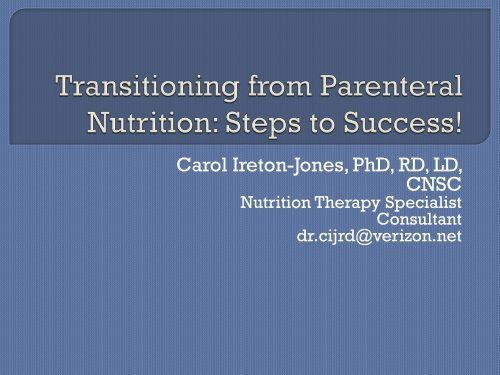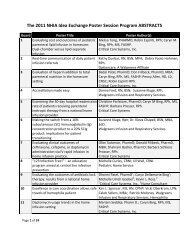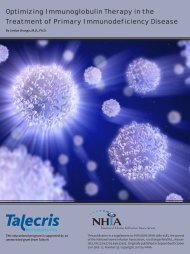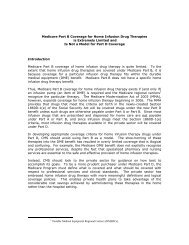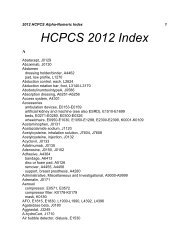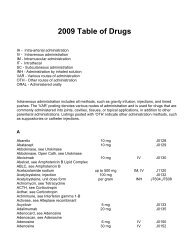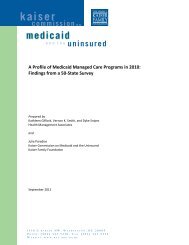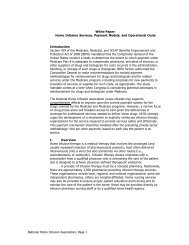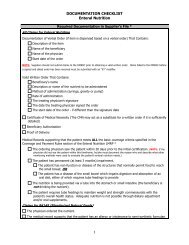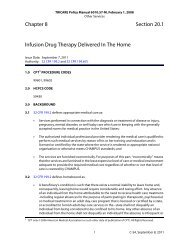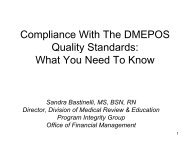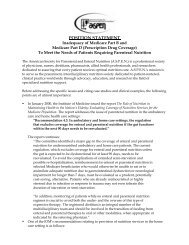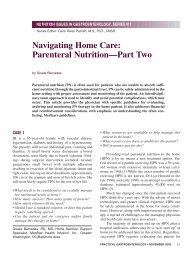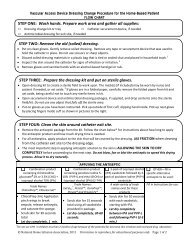Transitioning from Parenteral Nutrition: Steps to Successes! - NHIA
Transitioning from Parenteral Nutrition: Steps to Successes! - NHIA
Transitioning from Parenteral Nutrition: Steps to Successes! - NHIA
You also want an ePaper? Increase the reach of your titles
YUMPU automatically turns print PDFs into web optimized ePapers that Google loves.
Carol Ire<strong>to</strong>n-Jones, PhD, RD, LD,<br />
CNSC<br />
<strong>Nutrition</strong> Therapy Specialist<br />
Consultant<br />
dr.cijrd@verizon.net
The attendee will be able <strong>to</strong>:<br />
1. Identify an appropriate candidate for<br />
transition of PN dependence <strong>to</strong> EN or oral<br />
nutrition.<br />
2. Understand the types of EN formulas and<br />
oral diet considerations <strong>to</strong> use based on<br />
disease process and GI function<br />
3. Apply moni<strong>to</strong>ring techniques for<br />
assessing adequacy of nutrition intake -<br />
oral, EN or PN.
Oral<br />
<strong>Parenteral</strong><br />
Enteral<br />
<strong>Parenteral</strong>
<strong>Parenteral</strong> nutrition bypasses the normal digestion in<br />
the s<strong>to</strong>mach and bowel. It is a special liquid food<br />
mixture given in<strong>to</strong> the blood through an intravenous<br />
(IV) catheter (needle in the vein). The mixture contains<br />
proteins, carbohydrates (sugars), fats, vitamins and<br />
minerals (such as calcium). This special mixture may<br />
be called parenteral nutrition and was once called <strong>to</strong>tal<br />
parenteral nutrition (TPN), or hyperalimentation.<br />
www.nutritioncare.org<br />
Indications: Non-functioning GI tract or insufficient<br />
absorptive capacity<br />
• Short bowel syndrome<br />
• Ulcerative colitis/Crohn’s disease<br />
• Patients with high output fistulas<br />
• Intractable vomiting or nausea<br />
• Chronic pancreatitis<br />
• Bowel obstruction or GI hemorrhage<br />
• Enteral failure
Enteral nutrition or tube feeding is when<br />
a special liquid food mixture containing<br />
protein, carbohydrates (sugar), fats,<br />
vitamins and minerals, is given through a<br />
tube in<strong>to</strong> the s<strong>to</strong>mach or small bowel.<br />
www.nutritioncare.org
T<br />
I<br />
M<br />
I<br />
N<br />
g<br />
GI Tolerance
*based on several cases and not one specific<br />
patient case<br />
62 y/o female<br />
s/p gastric surgery due <strong>to</strong><br />
obstruction followed by<br />
intestinal resection. Fistula<br />
developed in hospital.<br />
PN started in the hospital –<br />
patient sent home on PN after<br />
2 weeks.<br />
Currently home on PN for 8<br />
weeks; fistula is now closed<br />
<br />
Now what?
Oral or enteral nutrition contraindicated?<br />
• If yes – continue PN<br />
• If no<br />
GI tract functional?<br />
• If no – continue PN<br />
• If yes – Evaluate GI ana<strong>to</strong>my:<br />
• Normal<br />
• S<strong>to</strong>mach<br />
• Small intestine<br />
• Colon
Esophagus<br />
• Swallowing?<br />
• Obstruction<br />
S<strong>to</strong>mach<br />
• Gastrec<strong>to</strong>my?<br />
• Obstruction?<br />
Small intestine<br />
• Length?<br />
• Function?<br />
• Ileocecal valve?<br />
Colon<br />
• Present?
GI ana<strong>to</strong>my -<br />
no swallowing<br />
disorder<br />
SBS -<br />
→Ready <strong>to</strong> assess<br />
<strong>to</strong>lerance <strong>to</strong> enteral<br />
nutrition<br />
GI ana<strong>to</strong>my –<br />
• Fistula closed<br />
• Wound vac removed<br />
• Patient is taking some<br />
liquids by mouth<br />
• How much SI is left?<br />
PN continues<br />
• Ready <strong>to</strong> wean?<br />
YES!<br />
• EN or oral?<br />
*based on several cases and not one specific<br />
patient case
Intact nutrients<br />
Most commonly used tube feeding formula<br />
Energy Density: 1.0 -2.0 kcal.ml<br />
• Nutrient dense formula’s 1.5 – 2.0 kcal/ml for fluid restriction, volume<br />
sensitive<br />
Protein: 14% <strong>to</strong> 25% of <strong>to</strong>tal calories<br />
• Very high protein formulas for increased protein needs i.e. wound<br />
healing, anabolism, PEM<br />
Fiber<br />
• With/without<br />
Low <strong>to</strong> moderate osmolality<br />
(300 <strong>to</strong> 700 mOsm/kg water)
Peptide –based<br />
• Malabsorption, maldigestion, Impaired gastrointestinal function and/or symp<strong>to</strong>m of GI<br />
in<strong>to</strong>lerance<br />
• Easily digested forms of carbohydrate, protein and fat<br />
• Protein: free amino acid and peptides<br />
• Carbohydrate: mono-, di- and oligosaccharides.<br />
• Fat: Medium chain triglycerides<br />
• Fiber-free, low residue, low fat<br />
• Low-lac<strong>to</strong>se<br />
Disease Specific<br />
• Cus<strong>to</strong>mized <strong>to</strong> meet needs of patients with specific diseases.<br />
• Diabetes formulas: <strong>to</strong> help manage blood glucose levels compared <strong>to</strong> standard products<br />
• Unique carbohydrate blend including slowly digesting carbohydrates<br />
• Renal formulas: <strong>to</strong> help minimize complications such as uremia, fluid overload, and<br />
elevated serum electrolytes<br />
• Energy dense ( 2.0 kcal/ml) <strong>to</strong> support fluid restrictions<br />
• Modified electrolytes and micronutrients
Access<br />
Enteral<br />
<strong>Nutrition</strong><br />
Nasogastric<br />
nasoduodenal tube<br />
Gastros<strong>to</strong>my tube<br />
Jejunos<strong>to</strong>my tube<br />
nasojejunal tube
Swallowing<br />
• Typically normal digestion<br />
Enteral formula?<br />
Enteral access?
Swallowing<br />
• Typically normal digestion<br />
Enteral formula: Standard – with fiber (i.e. Jevity ® )<br />
Enteral access: Naso-enteric or gastros<strong>to</strong>my<br />
(long-term or<br />
esophageal obstruction)
Partial or full gastrec<strong>to</strong>my?<br />
Gastroparesis?<br />
Obstruction?<br />
Enteral formula?<br />
Enteral access?
Partial or full gastrec<strong>to</strong>my?<br />
Gastroparesis?<br />
Obstruction?<br />
Enteral formula:<br />
Standard – with fiber (i.e. Jevity ® ) or without fiber (i.e.<br />
Osmolite ® )<br />
Disease specific - (i.e. Glucerna ® or Nepro ® )<br />
Enteral access: Naso-duodenal (by pass s<strong>to</strong>mach)<br />
or gastros<strong>to</strong>my <strong>to</strong> small intestine (may include<br />
venting - long-term)
Length?<br />
Function?<br />
Ileocecal valve?<br />
Enteral formula?<br />
Enteral access?
Length –<br />
• less than 50 cm with intact colon – peptide based enteral<br />
formula (i.e., Vital ® )naso enteric or gastros<strong>to</strong>my access → oral<br />
diet<br />
• less than 100 cm with ileocecal valve and some colon present –<br />
peptide based enteral formula – naso enteric or gastros<strong>to</strong>my<br />
access → oral diet<br />
• less than 50 cm without colon – lifelong PN likely<br />
• greater than 50 cm with intact colon – peptide based or<br />
standard enteral formula – naso enteric or gastros<strong>to</strong>my access<br />
→ oral diet<br />
Function –<br />
• Pseudoobstruction, Crohn’s disease, malabsorption – peptide<br />
based enteral formula – naso enteric or gastros<strong>to</strong>my access →<br />
oral diet
Medical <strong>Nutrition</strong> therapy<br />
Oral supplements<br />
High<br />
protein<br />
shake
<strong>Nutrition</strong> Recommendations based on:<br />
• GI ana<strong>to</strong>my<br />
• Absorptive capacity<br />
• Disease process – diabetes, IBD, IBS, SBS, oncology,<br />
etc<br />
• Fluid <strong>to</strong>lerance<br />
• Likes and dislikes<br />
Carbohydrate, protein, fat, fiber, and fluid<br />
recommendations are individualized<br />
Call on your Registered Dietitian!
GI ana<strong>to</strong>my - no<br />
swallowing disorder<br />
but with SBS - ready<br />
<strong>to</strong> assess <strong>to</strong>lerance<br />
<strong>to</strong> nutrition<br />
<br />
PN transition<br />
• Diet instruction – what <strong>to</strong> eat<br />
and how much<br />
<strong>Steps</strong> <strong>to</strong> wean<br />
1. Decrease 1-2 days/week of HPN<br />
2. Evaluate for <strong>to</strong>lerance, adequacy<br />
of oral intake<br />
3. Decrease HPN <strong>to</strong> 4 days/week<br />
4. Evaluate for <strong>to</strong>lerance, adequacy<br />
Decrease HPN <strong>to</strong> 2 days/wk or D/C<br />
OR<br />
1. Decrease volume or daily HPN<br />
Then , decrease days as above<br />
Keep fluids available if needed<br />
Pull line when transition is assured
COLON PRESENT<br />
CHO 50-60%<br />
PRO 20%<br />
FAT 20-30%<br />
Meals 5-6 daily<br />
Avoid oxalates<br />
Iso<strong>to</strong>nic/hypoosmolar<br />
fluids<br />
Soluble fiber 5-10<br />
g/day<br />
Lac<strong>to</strong>se as <strong>to</strong>lerated<br />
COLON ABSENT<br />
CHO 40-50%<br />
PRO 20%<br />
FAT 30-40%<br />
Meals 4-6 daily<br />
Oxalates: no restriction<br />
Iso<strong>to</strong>nic, high Na fluids<br />
Soluble fiber 5-10<br />
g/day<br />
Lac<strong>to</strong>se as <strong>to</strong>lerated<br />
Byrne et al. NCP 15:306, 2000 Slide courtesy of L. Matarese,<br />
PhD, RD
MNT –<br />
• Follow post SBS diet recommendations<br />
• Food logging<br />
• Assess for adequacy<br />
*based on several cases and not one specific<br />
patient case<br />
If not adequate, initiate EN<br />
• Access/moni<strong>to</strong>ring
Multi-vitamin and minerals!<br />
• Supplied in EN and PN – for oral diet, consider<br />
beginning an oral multivitamin plus adequate<br />
calcium and vitamin D<br />
Fluids!<br />
• Calculate 30-35 ml/kg or 8 glasses of fluid per<br />
day!<br />
• Appropriate fluids – ORS? Water? Sugar-free<br />
beverages? Calorie containing beverages?<br />
Moni<strong>to</strong>r….
Enteral:<br />
• Placement of access device<br />
• Initiate enteral feeding<br />
• Pump – overnight feeding<br />
• Bolus/Drip<br />
Oral<br />
• Diet instruction – what <strong>to</strong> eat and how much
1 – Assess ability <strong>to</strong> take enteral/oral diet<br />
2 – Decrease PN <strong>to</strong> 75% of needs<br />
3 – Add EN <strong>to</strong> make up 25-40% of needs<br />
4 – PN decreases as EN/oral increases<br />
5 - Try decreasing PN and increasing EN<br />
by 25% increments or 50/50 PN /EN then<br />
25% PN (or s<strong>to</strong>p) and 75- 100% EN/oral.<br />
**Don’t pull that line or tube until you are<br />
sure!
•Body Weight - gain or<br />
loss based on goals<br />
•Fluid status<br />
•Compliance<br />
•Comprehension<br />
• Diarrhea<br />
• Nausea/vomiting<br />
• Abdominal<br />
distention/cramping<br />
• Dehydration<br />
• Enteral access<br />
site/device<br />
• Disease<br />
progression &/or<br />
recovery<br />
• Lab and physical<br />
data
Transition <strong>from</strong> PN <strong>to</strong><br />
EN or oral diet<br />
Adequate intake<br />
without<br />
complications<br />
Continuing progress<br />
<strong>to</strong> goals!
The Oley Foundation – Don’t Go Home Without It!!!<br />
www.oley.org 800-776-OLEY (6539)


